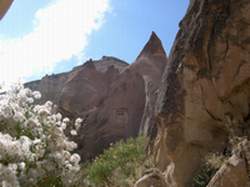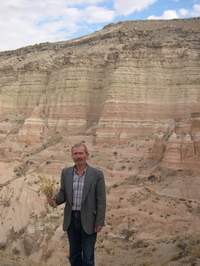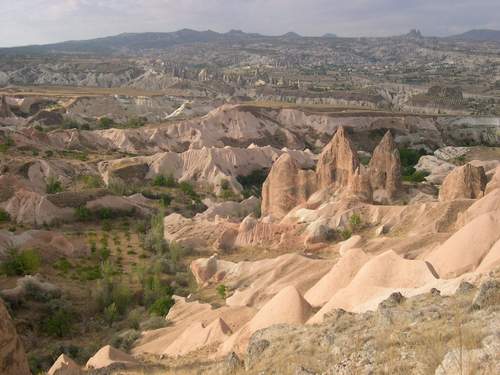|
 For the
majority of us, the day started at 7:15 when we took a short van ride
to Kizil Çukur where our morning hike began. The volcanic tuff cone
formations rose all around us like a dreamlike landscape sculpted by
giants. The arid-adapted native plants were mostly dormant and
provided Meli with a beautiful bouquet of dried flowers. Ismael, our
charming local guide, brought a gift for us of a bag of raisins dried
from the many grapes grown in the area on any available level ground
using pigeon droppings for fertilizer. People carve coveys in the tuff
and paint the openings with white or red decorative motifs to attract
the pigeons, where later they go to collect the valuable fertilizer.
Ismael talked to us about his mother hauling water in jugs for
drinking and about the care given to children by community members. If
a mother was in the fields, then a neighbor would make sure her
children were fed and someone would milk the cow if the owner wasn’t
around. After leaving our beautiful
hotel, Lale Saray in Űçhisar, For the
majority of us, the day started at 7:15 when we took a short van ride
to Kizil Çukur where our morning hike began. The volcanic tuff cone
formations rose all around us like a dreamlike landscape sculpted by
giants. The arid-adapted native plants were mostly dormant and
provided Meli with a beautiful bouquet of dried flowers. Ismael, our
charming local guide, brought a gift for us of a bag of raisins dried
from the many grapes grown in the area on any available level ground
using pigeon droppings for fertilizer. People carve coveys in the tuff
and paint the openings with white or red decorative motifs to attract
the pigeons, where later they go to collect the valuable fertilizer.
Ismael talked to us about his mother hauling water in jugs for
drinking and about the care given to children by community members. If
a mother was in the fields, then a neighbor would make sure her
children were fed and someone would milk the cow if the owner wasn’t
around. After leaving our beautiful
hotel, Lale Saray in Űçhisar,
 Hussein
drove us to Avanos. Located by the Red River (aptly named for the
color of its clay), Avanos has been the center of pottery making since
the time of the Hittites. There is a saying that “even a blind person
can find their way to Avanos by walking on the sherds” that
illustrates the long tradition of pottery making in the town. Avanos
is one of the few or perhaps the only town in Turkey where the statue
in the center of town is not of Ataturk. Instead, it is a composite of
a potter, women weaving kilims, and a man playing a saz.We spent an
enjoyable hour or so at Chez Galip, where the renowned potter and
proprietor demonstrated the art of throwing various pieces of
mysterious pottery on a foot wheel. When the pieces were put together,
they turned out to be a teapot! Most of us purchased at least one of
his masterpieces to take home and also went to look at his hair
museum- a cavern-like room filled with hanging bundles of hair from
friends and visitors from around the world. Fascinating, yet
disturbingly eerie. After leaving Chez Galip’s pottery workshop, we
visited next door at their kilim shop where a few of us found the
kilim of our dreams. Lunch was at a marvelous restaurant that served
up pomegranate, arugula, and parsley salad, lambchops or lamb kebaps,
and an angel hair-like desert called künufe. This is made by putting
dough in a sprinkler head, spraying it onto metal sheets, searing it,
and the resulting crispy desert is sprinkled with lemon/sugar water,
cheese, and pistachios-yummm. Hussein
drove us to Avanos. Located by the Red River (aptly named for the
color of its clay), Avanos has been the center of pottery making since
the time of the Hittites. There is a saying that “even a blind person
can find their way to Avanos by walking on the sherds” that
illustrates the long tradition of pottery making in the town. Avanos
is one of the few or perhaps the only town in Turkey where the statue
in the center of town is not of Ataturk. Instead, it is a composite of
a potter, women weaving kilims, and a man playing a saz.We spent an
enjoyable hour or so at Chez Galip, where the renowned potter and
proprietor demonstrated the art of throwing various pieces of
mysterious pottery on a foot wheel. When the pieces were put together,
they turned out to be a teapot! Most of us purchased at least one of
his masterpieces to take home and also went to look at his hair
museum- a cavern-like room filled with hanging bundles of hair from
friends and visitors from around the world. Fascinating, yet
disturbingly eerie. After leaving Chez Galip’s pottery workshop, we
visited next door at their kilim shop where a few of us found the
kilim of our dreams. Lunch was at a marvelous restaurant that served
up pomegranate, arugula, and parsley salad, lambchops or lamb kebaps,
and an angel hair-like desert called künufe. This is made by putting
dough in a sprinkler head, spraying it onto metal sheets, searing it,
and the resulting crispy desert is sprinkled with lemon/sugar water,
cheese, and pistachios-yummm.
 Our next
adventure of the day was a visit to the underground city of Kaymakli
where early Christians hid from persecution by the Romans. The city
was later used by the Byzantines to avoid attack from the Persians.
Eight levels of rooms and tunnels were painstakingly carved below
ground (only five are open to the public). Rooms were used for food
storage, a church, birthing, a winery (including troughs for pressing
grapes), communal kitchens, and stables among others. Because there
was a limited supply of oxygen, the refugees couldn’t have too many
fires so they lived primarily in the dark. A long ventilator shaft
supplied oxygen for the underground dwellers. Footholds were carved
into the sides of the shaft so that if their source of fresh air
became blocked, some brave soul could climb up to the mouth of the
shaft and unblock the opening. Looking down the shaft, it appeared
bottomless and the thought of climbing up using those precarious
footholds was horrifying. On the way to our final destination
of the day- Güzelyurt or Beautiful Homeland, it rained and we saw a
double rainbow! When we arrived at our Otel Karballa (built in 1853 as
a Christian girls’ school), Meli took us to the dining hall where,
listening to classical music and sipping homemade wine, she told us
the story of her first days as a tour guide and how she found this
place. She was a concessionaire for Rick Steve and the day had been
disastrous. First she got in an argument with him over the kind of
lunch they would provide for the tour members. Meli prevailed with her
idea for a picnic lunch. The first part of that day’s tour was to
Kaymakli. When they arrived, the electricity was off, so they went on
to a second underground city where the electricity was functioning
fine. However, when they emerged, it was pouring rain. What to do
about the picnic lunch? They decided to have it in the bus which was
not at all what Meli had in mind, but there was no other alternative.
So now Meli needed to decide where they were going to spend the night.
She saw a sign for Güzelyurt and asked her driver to take the group
there. When she arrived she was directed to the old girls’ school as
the best solution to her problem where the same scene that she
recreated for us took place- a perfect ending to such a disastrous
day! Her sharing this experience and recreating the scene for us
really touched our hearts. Some of us stayed until dinnertime to drink
Raki and converse. We then enjoyed a great buffet dinner and
retired early to get lots of sleep for the next day’s adventures Our next
adventure of the day was a visit to the underground city of Kaymakli
where early Christians hid from persecution by the Romans. The city
was later used by the Byzantines to avoid attack from the Persians.
Eight levels of rooms and tunnels were painstakingly carved below
ground (only five are open to the public). Rooms were used for food
storage, a church, birthing, a winery (including troughs for pressing
grapes), communal kitchens, and stables among others. Because there
was a limited supply of oxygen, the refugees couldn’t have too many
fires so they lived primarily in the dark. A long ventilator shaft
supplied oxygen for the underground dwellers. Footholds were carved
into the sides of the shaft so that if their source of fresh air
became blocked, some brave soul could climb up to the mouth of the
shaft and unblock the opening. Looking down the shaft, it appeared
bottomless and the thought of climbing up using those precarious
footholds was horrifying. On the way to our final destination
of the day- Güzelyurt or Beautiful Homeland, it rained and we saw a
double rainbow! When we arrived at our Otel Karballa (built in 1853 as
a Christian girls’ school), Meli took us to the dining hall where,
listening to classical music and sipping homemade wine, she told us
the story of her first days as a tour guide and how she found this
place. She was a concessionaire for Rick Steve and the day had been
disastrous. First she got in an argument with him over the kind of
lunch they would provide for the tour members. Meli prevailed with her
idea for a picnic lunch. The first part of that day’s tour was to
Kaymakli. When they arrived, the electricity was off, so they went on
to a second underground city where the electricity was functioning
fine. However, when they emerged, it was pouring rain. What to do
about the picnic lunch? They decided to have it in the bus which was
not at all what Meli had in mind, but there was no other alternative.
So now Meli needed to decide where they were going to spend the night.
She saw a sign for Güzelyurt and asked her driver to take the group
there. When she arrived she was directed to the old girls’ school as
the best solution to her problem where the same scene that she
recreated for us took place- a perfect ending to such a disastrous
day! Her sharing this experience and recreating the scene for us
really touched our hearts. Some of us stayed until dinnertime to drink
Raki and converse. We then enjoyed a great buffet dinner and
retired early to get lots of sleep for the next day’s adventures
|